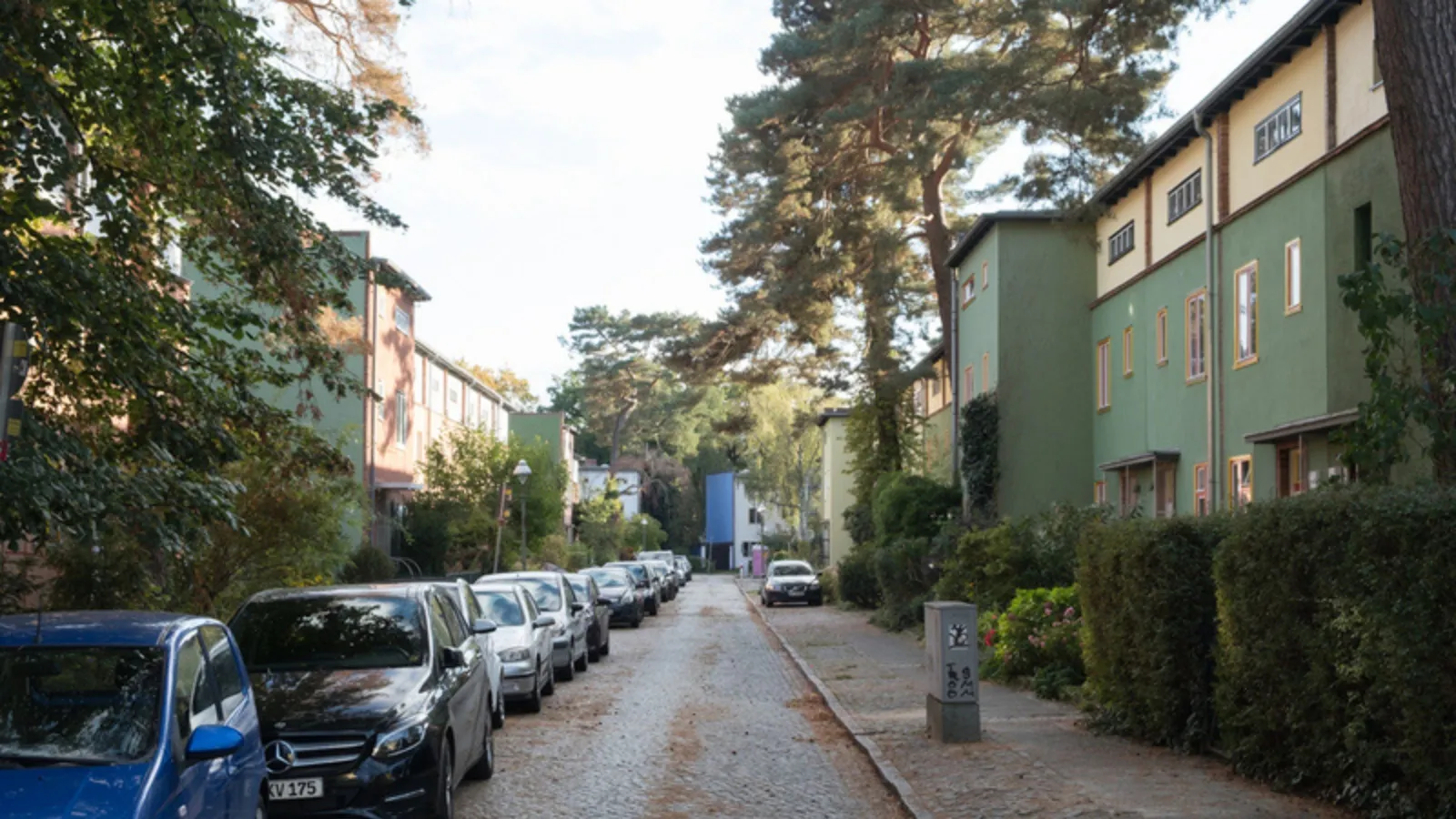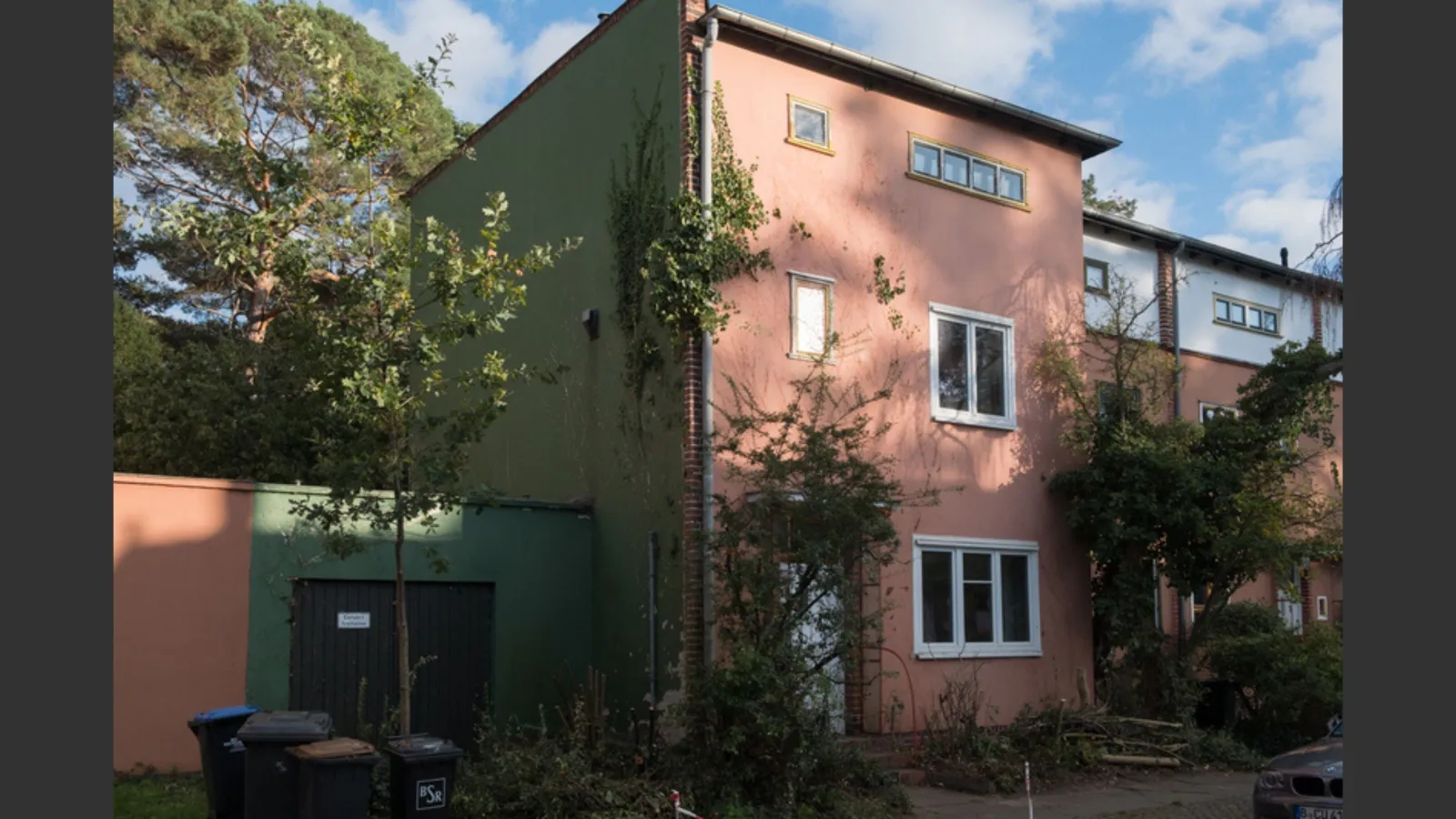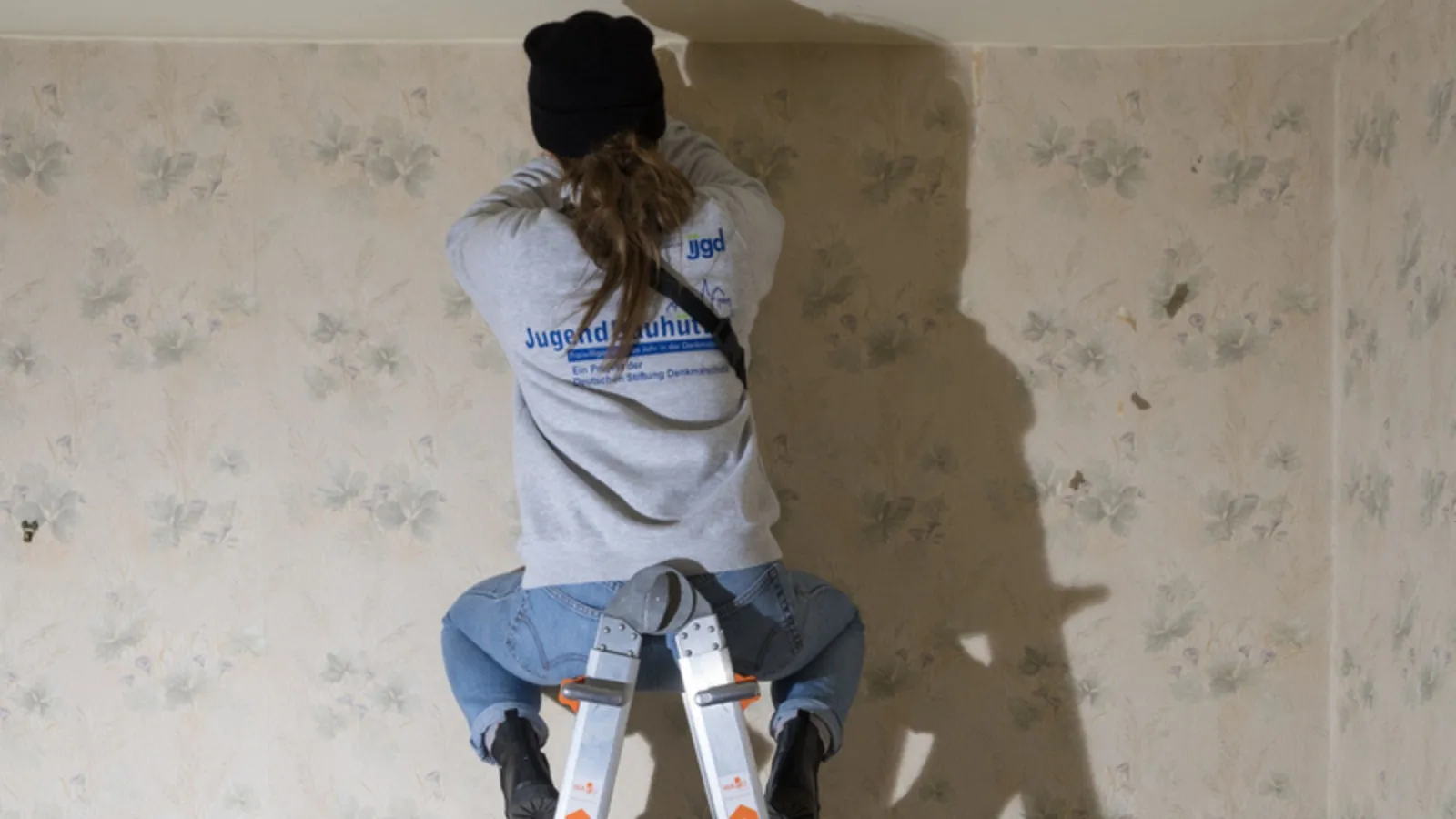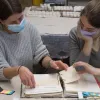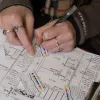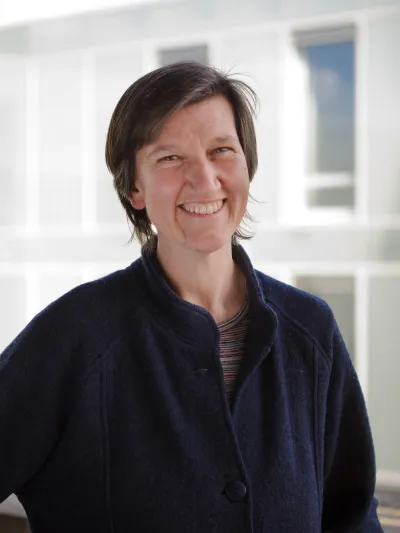Mural | The Terraced End House in Treibjagdweg 14 in the Onkel Tom housing estate
Inventory and examination for historical colourfulness

Location: Treibjagdweg 14, 14169 Berlin/Zehlendorf
Date of origin: 1929
Project agency: H&M
Type of documentation: Documentation of findings
Planning and conception Section V of the housing estate Onkel Tom: Architect Bruno Taut
Task
The task of this project includes a brief description of the rooms of the house (interior and exterior, including façades, veranda and garden), the compilation of a room book, the creation of stratigraphies as well as the determination of the colour value of the determined building-period colour layers and versions using the NCS system, the photographing and evaluation of the findings and the compilation of the present documentation in written and pictorial form. All rooms from the ground floor to the attic, including the staircase, the veranda and the exterior façades including the entrance area, were included in the investigation.
History
The "Waldsiedlung Zehlendorf" (Zehlendorf Forest Settlement), as the settlement was officially called, was built in the south-west of Berlin and was quickly and permanently named "Onkel Tom Siedlung". Designed by architect Bruno Taut, it was built by the Berlin housing company GEHAG (founded in 1924 as Gemeinnützige Heimstätten-, Spar- und Bau-Aktiengesellschaft) between 1926 - 1932, primarily to provide housing for middle-class families. The estate consists of 7 sections. In addition to Bruno Taut, Hugo Häring and Otto Rudolf Salvisberg, representatives of modern architecture, designed the housing estate according to Taut's urban development plans: Taut planned the northern section, Salvisberg the southern section and Häring the eastern section, incorporating the pine trees along the Grunewald. In Section V, which was designed and conceived solely by Bruno Taut, the row end house at Treibjagdweg 14 is the subject of this study. Due to the "Architektur der Moderne", which was ostracised in the 1920s and 1930s, along with the additional striking colour concept in terms of unusual colourfulness, the settlement was soon defamingly and mockingly called the "Papageien-Siedlung" by the National Socialists. Under this name, it is known today as an icon of modernist housing development and has been a listed building since 1991.
Description of the end-of-terrace house
The end-terrace house at Treibjagdweg 14 represents the type III,4 (4.1/2 rooms 102.00m2 living space) defined by Taut within the settlement. From Treibjagdweg, one looks from the west to the front of the terraced end house. From the rear east-facing garden, a garden gate leads to a narrow service road, which provides access to all terraced house gardens. The cubic building with a flat pitched monopitch roof closes the row of terraced houses Treibjagdweg 7 -14 to the north and thus has three free facade areas. The building has three storeys: ground floor, first floor and attic, and a full basement. Bruno Taut planned recurring window types throughout the entire terraced housing estate. A total of 13 different types were planned; the entrance door to the house is number 13, number 9 is the door from the kitchen to the veranda. The entrance door, as a design element with many variations within the settlement, is comparatively elaborate and richly combined. The entrance to the house is additionally set off and emphasised by a brick band within the façade and protected by a canopy and narrow lateral windbreak elements (wired glass in a metal frame) up to the height of the canopy. The rear or garden-side east façade of the terraced end house is divided into two (also coloured) sections. In this case, the ground floor is set apart from the upper two by the addition of a veranda, both architecturally and in terms of colour. The veranda, measuring 15m2 across the width of the house and 2.50 m deep, is separated from the terrace by a wooden railing (with a cover board approximately 3.00 m long). It is enclosed by solid walls to the north and south and covered with a wire-glass roof. The room layouts are approximately identical on all 3 floors, with the rooms arranged around the centrally located fireplace shaft.
Evaluation
Façade and window colours were specified according to Taut's documented colour plan. Façades and windows as well as all wooden fixtures in the interior of the house were frequently and sometimes radically reworked, which is why original colour tones are hardly to be found and are therefore difficult to verify. According to archival evidence, the plaster on the north and east façades was completely chipped off and reapplied. Only on the west façade could remnants of previous plaster/colours be found, without being able to conclude with certainty what the original design was. If, however, these were original remnants of plaster on the west façade with the reddish-brown façade colour "Keim 95" intended by Taut, then this would have been executed less as a coat of paint due to its appearance, but rather as a solid-coloured mineral plaster, consequently a thin noble plaster, as it emerged in the 1920s as a modern coating system and was used in many cases. The floor plans of the respective floors of all four levels are similar, the staircase along the north wall has a connecting effect, the narrow short corridors on each floor are considered distribution rooms to the respective rooms. The narrow staircase was designed by Taut, was installed as standard and was also specified in terms of colour. Floors: In the hallway and most of the rooms there are wooden floorboards, probably painted oxblood. There is terrazzo flooring in the bathroom and kitchen, cement screed in the cellar, and the terrace floor is made of standing rows of bricks around square fields filled with screed. However, it was found that all rooms were very colourful: red/brownish, dark blue, green, yellow/beige? Moreover, even the ceilings were partly painted in a lighter shade of colour. Wallpaper was not originally planned. The colours within each room were the same for all 4 walls up to the top of the ceiling. All walls have a straight edge to the plastered ceiling. The light-coloured running ceiling of the staircase is decorated with a stucco strip at the connection to the wall, which was set off in colour as a red band, as it were as a connecting element of the storey levels. The kitchen and bathroom were kept in light beige tones, some beige tiles (made in Meissen/Saxonia) including hooks for hanging pot holders etc. are still partly original, as is the storage cupboard below the kitchen window and presumably the wall unit on the north wall. There are hard-wearing terrazzo floors in these two rooms. The entrance area and corridors, as well as the staircase itself, were decorated in a light beige to yellow colour, the doors were all uniformly creamy white, the wide balusters of the staircase were white, the handrail black and presumably the string of the stairs also black, and the treads and risers of the staircase were painted grey. In the hallway and most of the rooms there are wooden floorboards, probably originally painted oxblood, including the skirting boards. The corridor levels to the north of the house, which are connected by a narrow, narrow staircase, serve as distribution rooms with their many doors to the individual rooms of the respective floors (ground floor, first floor and attic).
Summary
It has not been clarified whether Bruno Taut actually prescribed the interior design to the future residents, whether the flats were already completely painted in colour when they were first occupied, taking into account the preferences of the respective apartment/house occupants, or not. Records from the architect himself have not yet been found. It would be all the more interesting to collect and compare further examples of colour studies of the interiors within this settlement. It would be worthwhile to compare whether there could be a direct connection between the colours of the exterior façades and the interiors. Perhaps this will gradually lead to a system of colour design in the interior, as the design of the outer shells has been sufficiently documented by the architect himself.
Source for all plan materials used as well as colour systematics of façades and windows:
Pitz, Helge/Brenne, Winfried: Siedlung Onkel Tom Zehlendorf – Einfamilienreihenhäuser 1929, (=> Die Bauwerke und Kunstdenkmäler von Berlin, Beiheft 1), Berlin 1980.
Tjalda Eschebach
Project participants
Project support
Students
- Elena Böck
- Emily Göres
- Leona Yasmin Liehmann
- Jasmin Hahm
- Hanna Radt
- Elisabeth Haar
- Maya Sanchez
- Maika Hansel
- Felix Voß
